If you’re an astronomer and you want to escape the Earth’s hazy atmosphere, you need a space telescope… right? Not necessarily, sometimes all you need is a balloon, and some clear arctic skies. An international team of researchers traveled to Sweden and deployed a 33-storey tall balloon carrying the BLAST telescope, designed to study the birth of stars and planets. Gaelen Marsden is a member of the team, and researcher at the University of British Columbia in Vancouver, Canada.
Continue reading “Podcast: Having a BLAST in the Arctic”
Audio: Having a BLAST in the Arctic
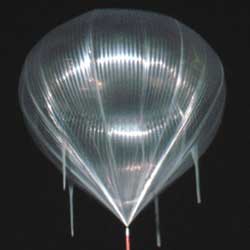
Giant balloon carrying the BLAST instrument into the high atmosphere. Image credit: Joe Martz. Click to enlarge.
Listen to the interview: Having a BLAST in the Arctic (4.5 MB)
Or subscribe to the Podcast: universetoday.com/audio.xml
Fraser Cain: It’s nice to finally have a chance to talk to someone from my home town. How’s the weather there?
Gaelen Marsden: Oh, it’s pretty nice today, nice and sunny.
Fraser: And how does it compare to northern Sweden?
Marsden: Well, it gets dark, which is pretty great.
Fraser: Right, right, 24 hours of sunlight. Can you give me some background on the mission that you just came back from in the North?
Marsden: So, it’s a balloon borne telescope, and carries a 2 metre mirror. BLAST stands for balloon borne large aperture submillimeter telescope. We fly in a balloon to an altitude of 40 kilometres. The 2 metre mirror, which is fairly large for a balloon – it’s nothing compared to ground-based telescopes – but it’s big for a balloon and comparable to current satellite telescopes. We’re measuring in the submillimeter, which is a new frontier. There are a few ground-based telescopes that measure in the submillimeter, but we’re the first ones to do it from near space, not quite space. The advantage to submillimeter is that you’re looking at – in the case of the extragalactic science targets – reprocessed light from very large stars; bright heavy stars as their galaxies first turn on with a flash of star formation. Along with the star formation, you have dust, and the dust absorbs the light from the stars and re-radiates it in the submillimeter. So that’s what we’re looking at.
Fraser: How does a balloon stand as a platform for having an observatory?
Marsden: Right, it’s a quick, cheap, dirty alternative to a satellite. We’re actually piggybacking on the European Space Agency’s called Herschel, which has an experiment on board called SPIRE. We’re using the same detectors and a similar mirror, and they will fly, I believe in 2007; although, it’ll probably be 2008. They’ll do a better job than us. They’re in space, there’s no atmosphere at all, they’ll have much longer observing time, but on the other hand, it costs 100 times as much and takes 10-15 years. Whereas, we put this together in about 5 years. That’s the read advantage; it’s very quick and it’s much cheaper.
Fraser: What other kinds of observations do you think could be done from a balloon-based observatory?
Marsden: Ballooning is nothing new. It’s been going on for probably 30-40 years. One of the most famous ones is the Boomerang telescope, which flew from Antarctica in, I believe, 1998-2000. And that’s CMB, Cosmic Microwave Background studies. There’s been a whole slew of balloon-borne telescopes looking at the Cosmic Microwave Background. And then also it’s very common in atmospheric sciences to use balloons.
Fraser: You launched the balloon a couple of weeks ago from Sweden. Where did it go, and what happened to it?
Marsden: Right, so we launched it Saturday morning. First it goes up, it takes about 3 hours to get to the destination altitude of 38 km, actually we were a little higher than that at first, I think we were closer to just over 39 km. The winds are fairly predictable, these high altitude winds. This is why we do it from Sweden, or from Antarctica. During the summer, the winds go in a circle. Not that we know exactly what it’s going to do, but you know it’s going to go West during the summer. And it did go West. It ended up going quicker than were hoping. The wind models were showing about 20 knots and we were going as fast as 40 knots some of the time. That ended up slowing us down. We were hoping to take 5 days to get across to the Northwest Territories, and it actually ended up being 4 days. And another problem is that we drifted north which caused problems because we wanted to fly all the way across to Alaska, but we ended up being too far north, and we had to cut down to Victoria Island instead, which cut off another 18 hours.
Fraser: So the balloon came around the pole and then drifted over northern Canada. How did you retrieve it?
Marsden: Two members of the team, Mark Devlin and Jeff Klein, both from the University of Pennsylvania, left Sweden after the first day. When the balloon launches, we get line of site telemetry. We get all of the data through a dish. For the first 18 hours or so, we’re getting all of the data. We’re all looking at it carefully, and it’s really important that we get everything set up properly for the rest of the flight to go smoothly. Eventually it passes over the mountains, and we don’t get that high data rate any more, and we get much less – by a factor of like a 1000 or so – data rate. So, for the rest of the flight, we just had a trickle of data coming in. But as soon as the line of sight data was over, Mark and Jeff left Sweden, flew back to Philidelphia, and then quickly left for Northwest Territories, and they were nearby when the balloon came down. It sounds like a fairly difficult task because it was quite remote, and they had to fly in by helicopter. They had to cut the thing up into fairly small pieces to retrieve it all.
Fraser: Now, if I understand correctly, the submillimeter is at the high end of the radio spectrum, and it’s really good for looking at cold objects. So, what exactly were you looking at?
Marsden: From the beginning, the science proposal stated that we had two cases: the extragalactic and also the galactic. Extragalactic was what I was talking about earlier, this high star formation in very young galaxies, and redshifts of up to 3, and possibly 5. That was the extragalactic case. There’s also the galactic case, where we’re looking at planet formation and dust in our own galaxy which is, at this point, not very well known. And it actually turned out that due to the sensitivity of the telescope being lower than we had hoped, we decided that it wasn’t the best use of our time to spend a lot of our time looking at the extragalactic sources. We actually spent most of our time looking at galactic sources because they’re closer, larger, brighter, easier things to see. In the galactic case, I actually myself don’t know a whole lot about the science because I’ve been spending my time studying extragalactic. But we’re looking at cold dust clouds in our own galaxy. Some of them will be forming stars and planets, which at this point is not well known. There are many wavelength observations of all these things, and we’re trying to add the submillimeter portion of it, so that you can look at these sources in the radio, although, I suspect you don’t see them very brightly in radio, but certainly optical. You see these pretty pictures from Hubble of these dusty nebulae, and we’re just adding the submillemeter presence to that curve to see if we can figure out what’s actually going on there.
Fraser: Do you have any more missions planned, or follow up observations?
Marsden: Yeah, definitely. We’re hoping to learn from the things that went wrong here. We had some problems in the flight, certainly we got a lot of science, and we’re very excited about it. There will be a lot of good things coming out of it, but we still want to go after the extragalactic stuff. We’re going to spend the next year or so putting everything back together and then try to get a handle on the things that went wrong with the flight. We’re hoping to turn around for another flight in 18 months from Antarctica.
What’s Up This Week – June 27 – July 3, 2005
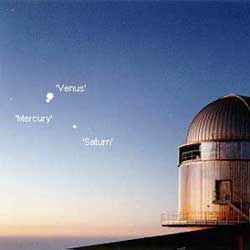
Visualization of skies on June 27. Nordic Optical Telescope. Image credit: Jacob Clasen. Click to enlarge.
Monday, June 27 – You asked for something cool? You got it. Tonight Venus and Mercury will be so close to each other for American viewers that their apparent separation will depend mainly on your viewing position. Known as an appulse, viewers in the east will catch the pair around 7 arcminutes apart – that’s just a fraction over one-tenth of a degree! In the west, the separation will be nearer 9 arcminutes, and if you observe in Hawaii? 10 arcminutes. Be sure to take the opportunity to see the very closest planetary pairing of the year! Wishing you all clear skies…
Be on the lookout tonight for a handful of meteors originating near the constellation of Corvus. The Corvid meteor shower is not well documented, but you might spot as many as ten per hour.
Tuesday, June 28 – Our splendid sunset dance of the planets continues as tonight Mercury has shuttled less than half a degree to the left of Venus and Saturn has slid to the lower right of our close pairing as they continue to rise. Still in range of most binocular fields, Venus and Saturn have now separated by about three and half degrees.
With the time of Deep Impact growing closer by the hour, I am not going to leave you alone until you locate this comet for yourself! Rapidly approaching perihelion, 9/P Tempel 1 is roughly the same brightness as the “Ring” nebula – so what are you waiting for? About a degree and a half northeast of Spica, you can easily spot star 76 in binoculars or finderscope, and the comet is just to its west. Once you locate it, it will be easy to follow as it continues slowly due south. Don’t wait until the last minute to view this comet, because as all astronomers know – you don’t make a “date” with the sky, it makes one with you!
Wednesday, June 29 – Are you enjoying the intriguing show of the planets? Then get up early to catch Mars and the Moon roughly four degrees apart! Watch the planets again after sunset as speedy Mercury continues to distance itself from Venus. They will appear slightly more than half a degree apart. What we are witnessing is Mercury turning around in its orbit and it’s just luck that it happens to be near Venus from our viewpoint.
Today we celebrate the birthday of George Ellery Hale, who was born in 1868. Hale was the founding father of the Mt. Wilson Observatory. Although he had no education beyond his baccalaureate in physics, he became the leading astronomer of his day. He invented the spectroheliograph, coined the word astrophysics and founded the Astrophysical Journal as well as Yerkes Observatory. At the time, Mt. Wilson dominated the world of astronomy, confirming what galaxies were and verifying the expanding universe cosmology, making Mt. Wilson one of the most productive facilities ever built. When Hale went on to found Palomar Observatory, the 5-meter (200″) telescope was named for him and dedicated on June 3, 1948. It continues to be the largest telescope in the continental United States.
Let’s celebrate Hale’s achievements tonight by viewing a pair of interacting galaxies. 40′ northwest of Beta Canum Venaticorum is NGC 4490 and smaller, fainter companion NGC 4485. This pair, also known as Arp 269, are quite unusual in appearance to the larger scope. NGC 4490 is around magnitude 10 and shows a bright, irregular core region and a rather strange profile. Known as the “Cocoon” galaxy, it appears to almost reach toward its companion 3′ to the north. Progressively larger scopes under ideal conditions will be able to make out some faint mottling in the NGC 4490’s structure.
Thursday, June 30 – And the show goes on. Mercury and Venus are separated by close to one degree tonight, and this is getting to be your last chance to catch Saturn before it quickly blends in with the twilight glow.
With the Moon comfortably out of the way, tonight would be an excellent opportunity to just find a comfortable seat, relax and watch for the June Draconid meteor shower. The radiant for this shower will be near handle of Big Dipper – Ursa Major. The fall rate varies from 10 to 100 per hour, but tonight’s darker skies will offer us a better than usual chance to spot the offspring of comet Pons-Winnecke. On a curious note, today in 1908 was when the great Tunguska impact happened in Siberia. A fragment of a comet, perhaps?
Friday, July 1 – Tonight we honor southern skies by exploring the fantastic, NGC 3372 – the Eta Carinae Nebula. As a giant, diffuse nebula with a visual brightness of magnitude 1, (wow!) it contains the most massive and luminous star in our Milky Way galaxy, Eta Carinae. It’s also home to a small cluster, Collinder 228, which is only one of 8 cataloged open clusters within the area of this huge star-forming region; the others are Bochum (Bo) 10, Trumpler (Tr) 14 (also cataloged as Cr 230), Tr 15 (= Cr 231), Cr 232, Tr 16 (= Cr 233), Cr 234, and Bo 11. Star Eta Carinae is involved in open cluster Trumpler 16. This fantastic nebula contains details which northerners can only dream about, such as the dark “Keyhole” and the “Homunkulus” around the giant star itself. A fantastic region for exploration with both telescopes and binoculars!
Saturday, July 2 – For west, central, and southern Europe, the Moon will occult Delta Aries for you on this universal date. Please check this IOTA webpage for more details on times in your area. For our southern hemisphere friends, tonight will be very busy. Starting with New Zealand, the Moon will occult 4th magnitude 23 Tauri, 3rd magnitude Alcyone, and head towards southeast and central Australia for 27 Tauri all on this same universal date.
Today marks the 20th anniversary of the comet Halley mission – Giotto – launch. Comets are going to be very much in the news over the next few days and if you have not taken the time to look for Deep Impact’s target, Tempel 1, let’s try again tonight. Just marginally due east (about a degree and a half) of bright Spica, our comet should have brightened to magnitude 9 by this time – putting it well within the capabilities of small scopes and large binoculars. Larger telescopes will easily note a bright, almost stellar nucleus and broad fan of tail. Tempel 1 will continue southward, passing almost mid-way between Gamma Virginis and star 68 by tomorrow night. Don’t miss this opportunity!
Sunday, July 3 – Time is up. Today is the scheduled time for the Deep Impact mission to release the impactor. The clock is ticking and if you still haven’t located 9/P Tempel 1, try again tonight! There are no deep sky objects even remotely close to Tempel 1’s brightness in the area between Gamma and star 68 Virginis. Even if you have only modest binoculars, please check out the field. Place blue/white Spica, (the brightest star near Jupiter) just to the right of the field of view and you will see two visible orangish stars equidistant toward the left. It is between (and slightly below) these two stars that Deep Impact will occur and there is a strong possibility that it will flare brightly enough over the next couple of days to reach near unaided visibility. If you live in a light polluted area, it would be quite worth the drive to a darker location the keep track of this event. It’s out there… And it’s only about 400 light seconds away!
Wishing you all clear skies! May all your journeys be at Light Speed… ~Tammy Plotner
Electric Shield for Astronauts on the Moon
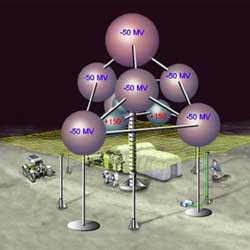
Artist illustration of an electromagnetic shield that could protect astronauts. Image credit: Hubble. Click to enlarge.
Opposite charges attract. Like charges repel. It’s the first lesson of electromagnetism and, someday, it could save the lives of astronauts.
NASA’s Vision for Space Exploration calls for a return to the Moon as preparation for even longer journeys to Mars and beyond. But there’s a potential showstopper: radiation.
Space beyond low-Earth orbit is awash with intense radiation from the Sun and from deep galactic sources such as supernovas. Astronauts en route to the Moon and Mars are going to be exposed to this radiation, increasing their risk of getting cancer and other maladies. Finding a good shield is important.
The most common way to deal with radiation is simply to physically block it, as the thick concrete around a nuclear reactor does. But making spaceships from concrete is not an option. (Interestingly, it might be possible to build a moonbase from a concrete mixture of moondust and water, if water can be found on the Moon, but that’s another story.) NASA scientists are investigating many radiation-blocking materials such as aluminum, advanced plastics and liquid hydrogen. Each has its own advantages and disadvantages.
Those are all physical solutions. There is another possibility, one with no physical substance but plenty of shielding power: a force field.
Most of the dangerous radiation in space consists of electrically charged particles: high-speed electrons and protons from the Sun, and massive, positively charged atomic nuclei from distant supernovas.
Like charges repel. So why not protect astronauts by surrounding them with a powerful electric field that has the same charge as the incoming radiation, thus deflecting the radiation away?
Many experts are skeptical that electric fields can be made to protect astronauts. But Charles Buhler and John Lane, both scientists with ASRC Aerospace Corporation at NASA’s Kennedy Space Center, believe it can be done. They’ve received support from the NASA Institute for Advanced Concepts, whose job is to fund studies of far-out ideas, to investigate the possibility of electric shields for lunar bases.
“Using electric fields to repel radiation was one of the first ideas back in the 1950s, when scientists started to look at the problem of protecting astronauts from radiation,” Buhler says. “They quickly dropped the idea, though, because it seemed like the high voltages needed and the awkward designs that they thought would be necessary (for example, putting the astronauts inside two concentric metal spheres) would make such an electric shield impractical.”
Buhler and Lane’s approach is different. In their concept, a lunar base would have a half dozen or so inflatable, conductive spheres about 5 meters across mounted above the base. The spheres would then be charged up to a very high static-electrical potential: 100 megavolts or more. This voltage is very large but because there would be very little current flowing (the charge would sit statically on the spheres), not much power would be needed to maintain the charge.
The spheres would be made of a thin, strong fabric (such as Vectran, which was used for the landing balloons that cushioned the impact for the Mars Exploration Rovers) and coated with a very thin layer of a conductor such as gold. The fabric spheres could be folded up for transport and then inflated by simply loading them with an electric charge; the like charges of the electrons in the gold layer repel each other and force the sphere to expand outward.
Placing the spheres far overhead would reduce the danger of astronauts touching them. By carefully choosing the arrangement of the spheres, scientists can maximize their effectiveness at repelling radiation while minimizing their impact on astronauts and equipment at the ground. In some designs, in fact, the net electric field at ground level is zero, thus alleviating any potential health risks from these strong electric fields.
Buhler and Lane are still searching for the best arrangement: Part of the challenge is that radiation comes as both positively and negatively charged particles. The spheres must be arranged so that the electric field is, say, negative far above the base (to repel negative particles) and positive closer to the ground (to repel the positive particles). “We’ve already simulated three geometries that might work,” says Buhler.
Portable designs might even be mounted onto “moon buggy” lunar rovers to offer protection for astronauts as they explore the surface, Buhler imagines.
It sounds wonderful, but there are many scientific and engineering problems yet to be solved. For example, skeptics note that an electrostatic shield on the Moon is susceptible to being short circuited by floating moondust, which is itself charged by solar ultraviolet radiation. Solar wind blowing across the shield can cause problems, too. Electrons and protons in the wind could become trapped by the maze of forces that make up the shield, leading to strong and unintended electrical currents right above the heads of the astronauts.
The research is still preliminary, Buhler stresses. Moondust, solar wind and other problems are still being investigated. It may be that a different kind of shield would work better, for instance, a superconducting magnetic field. These wild ideas have yet to sort themselves out.
But, who knows, perhaps one day astronauts on the Moon and Mars will work safely, protected by a simple principle of electromagnetism even a child can understand.
Original Source: Science@NASA
Hubble Sees a Jet on Comet Tempel 1
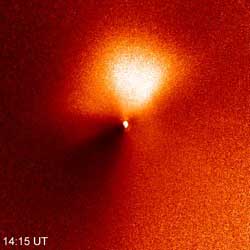
Hubble view of a jet on Comet Tempel 1. Image credit: Hubble. Click to enlarge.
In a dress rehearsal for the rendezvous between NASA’s Deep Impact spacecraft and comet 9P/Tempel 1, the Hubble Space Telescope captured dramatic images of a new jet of dust streaming from the icy comet.
The images are a reminder that Tempel 1’s icy nucleus, roughly half the size of Manhattan, is dynamic and volatile. Astronomers hope the eruption of dust seen in these observations is a preview of the fireworks that may come July 4, when a probe from the Deep Impact spacecraft will slam into the comet, possibly blasting off material and giving rise to a similar dust plume.
These observations demonstrate that Hubble’s sharp “eye” can see exquisite details of the comet’s temperamental activities. The Earth-orbiting observatory was 75 million miles away from the comet when these images were taken by the Advanced Camera for Surveys’ High Resolution Camera. The telescope’s views complement close-up images being taken by cameras aboard Deep Impact, which is speeding toward the comet.
The two images, taken seven hours apart on June 14, show Tempel 1 and its new jet. The image at left, taken at 2:17 a.m. (EDT), is a view of the comet before the outburst. The bright dot is light reflecting from the comet’s nucleus, which appears star-like in these images because it is too small even for Hubble to resolve. The nucleus, a potato-shaped object, is 8.7 miles (14 kilometers) wide and 2.5 miles (4 kilometers) long. Hubble’s viewing the nucleus is as difficult as someone trying to spot a potato in Salt Lake City from New York City.
The photo at right, snapped at 9:15 a.m. (EDT), reveals the jet [the bright fan-shaped area]. The jet extends about 1,400 miles (2,200 kilometers), which is roughly half the distance across the U.S. It is pointing in the direction of the Sun. Comets frequently show outbursts in activity, but astronomers still don’t know exactly why they occur. Tempel 1 has been moving closer to the Sun, and perhaps the increasing heat opened up a crack in the comet’s dark, crusty surface. Dust and gas trapped beneath the surface could then spew out of the crack, forming a jet. Or, perhaps a portion of the crust itself was lifted off the nucleus by the pressure of heated gases beneath the surface. This porous crust might then crumble into small dust particles shortly after leaving the nucleus, producing a fan-shaped coma on the sunward side. Whatever the cause, the new feature may not last for long.
Astronomers hope that the July 4 collision will unleash more primordial material trapped inside the comet, which formed billions of years ago. Comets are thought to be “dirty snowballs,” porous agglomerates of ice and rock that dwell in the frigid outer boundaries of our solar system. Periodically, they make their journey into the inner solar system as they loop around the Sun.
The contrast in these images has been enhanced to highlight the brightness of the new jet.
Original Source: Hubble News Release
Making the Mirror for the World’s Largest Telescope
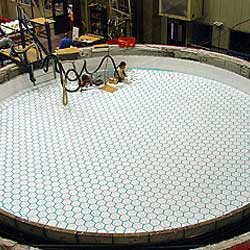
Workers completing the mold of the 8.4 metre mirror for the Giant Magellan Telescope mirror. Image credit: Lori Stiles/UA. Click to enlarge.
The University of Arizona’s Steward Observatory Mirror Lab is pre-firing its huge spinning furnace and inspecting tons of glass for casting a first 8.4-meter (27-foot) diameter mirror for the Giant Magellan Telescope (GMT). The casting is scheduled for Saturday, July 23.
With this milestone step, the GMT becomes the first extremely large ground-based telescope to start construction.
The completed GMT telescope primary mirror will consist of six 8.4-meter off-axis mirrors surrounding a seventh, on-axis central mirror. (An off-axis mirror focuses light at an angle away from its axis, unlike a symmetrical mirror that focuses light along its axis.) This arrangement will give the GMT four-and-one-half times the collecting area of any current optical telescope and the resolving power of a 25.6-meter (84-foot) diameter telescope, or 10 times the resolution of the Hubble Space Telescope.
‘Spin-casting’ single-piece telescope mirrors that are giant, stiff yet lightweight is an ingenious, awesome process that was conceived and developed by University of Arizona Regents’ Professor of astronomy J. Roger P. Angel. Casting giant monolithic mirrors is accomplished at only one place in the world — the Steward Observatory Mirror Laboratory.
The casting team, headed by Randy Lutz, installed about 50 cores a day for a total 1,681 cores during seven weeks in April – May. The team bolted each core at precisely measured angles to hearth tile and adjoining cores in this operation. The crew daubed all the glued junctures with blue “smurf” – a concoction the color of the blue smurf cartoon characters — to prevent glass from sticking to the mold.
At this point, the mold holds 17,000 pounds of hearth tiles, 16,000 pounds in fiber tub walls, and 15,000 pounds of cores and pins. The casting team has now cleaned and inspected the completed mold, lowered the furnace cover into place, and begun pre-firing on June 16.
Team members actively ‘pilot’ the furnace by computer as temperatures ramp up during the first 8 days of the heating process, then shut power off to complete the two-week pre-firing. Pre-firing centers core glue joints, burns out any impurities and stresses the mold. The casting team will inspect the mold for any needed repairs after pre-firing.
Some of the most visually stunning steps in casting are glass inspection and loading. The team began inspecting 90 shipping crates of glass on June 24. Glass loading is scheduled for the second week of July, said Steve Miller, Mirror Lab manager.
The 40,000 pounds of borosilicate glass that will make the 27-foot diameter (8.4 meter) GMT mirror comes from Ohara Glassworks in Japan. Ohara made the glass from sand that comes from the gulf coast of Florida.
The Mirror Lab will start heating the furnace July 18. It takes six days for the glass to reach peak temperature at 2,150 degrees Fahrenheit (1178 Celsius). At this temperature, the glass begins to flow like honey at room temperature. The thick liquid glass flows between the hexagonal cores in the mold to create a “honeycomb” structure. The final honeycomb mirror blank will weigh about a fifth as much as a solid glass mirror of its size.
The bearings on the rotating furnace will turn a 100-ton load during spincasting. The furnace can be supplied with up to 1.1 Megawatts of electricity during casting — enough to power an average 750 to 1,100 Tucson households, depending on the time of year.
The oven’s rotation rate determines the depth of the curve spun into the shape of the mirror, or the mirror’s focal length. The GMT mirror will spin 5 times a minute, slower than the two 8.4-meter mirrors the Lab made for the Large Binocular Telescope (LBT), because the off-axis GMT mirror is to be a shallower, longer focal-length mirror than the symmetric LBT primaries.
“This is a new epoch for astronomy,” Richard Meserve, president of the Carnegie Institution, said. “The fabrication of the off-axis mirror is a path-breaking event that will advance scientific discovery. Everyone in the eight-member GMT consortium is excited that we’re in production.”
The Giant Magellan Telescope consortium currently includes the Carnegie Observatories, Harvard University, Smithsonian Astrophysical Observatory, University of Arizona, University of Michigan, Massachusetts Institute of Technology, University of Texas at Austin, and Texas A & M University.
“The fact that we are already in production is directly related to the successful technology developed for the twin 6.5-meter (21-foot) Magellan telescopes at Carnegie’s Las Campanas Observatory in Chile,” said Matt Johns, assistant director of the Carnegie Observatories and GMT project manager. “The Magellan telescopes have proved to be the best natural imaging telescopes on the ground.”
Mirror cooling is a carefully controlled process that will take 11 to 12 weeks. After the mirror is completely cooled, the lab will wash the ceramic cores out of the mirror’s glass honeycomb cells. Then the mirror will be ground and polished to an accuracy of plus-or-minus 15 to 20 nanometers (a nanometer is a billionth of a meter). The mirror will be coated with a layer of reflective aluminum only 100 nanometers thick at the observatory site.
The GMT is slated for completion in 2016 at a site in northern Chile. With its powerful resolution and enormous collecting area, it will be able to probe the most important questions in astronomy, including the birth of stars and planetary systems in our Milky Way, the mysteries of black holes, and the genesis of galaxies.
Detailed information about the GMT design and science goals is online at http://www.gmto.org/
Original Source: UA News Release
Satellite View of Istanbul
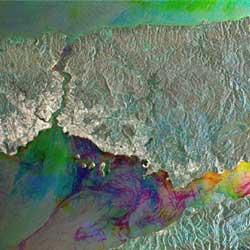
Radar satellite view of Istanbul. Image credit: ESA. Click to enlarge.
The city of Istanbul, located astride the eastern edge of Europe and western edge of the Asian continent, shown in an Envisat radar multi-temporal composite image.
What is today Europe’s third largest urban centre has been a major city for the last two thousand years. It has known three different names in that time: Byzantium when it was the gateway to Greek settlements on the Black Sea, Constantinople when it became the capital of the Eastern Roman Empire, then Istanbul when it fell to Muslim invaders in 1453.
In 1919 Istanbul lost its position as capital of Turkey, but remains that country’s leading economic centre. Its population has grown from 2.84 million in 1970 to around ten million today, with settlers flocking from rural areas of Anatolia. Around 30% of all the cars owned in Turkey are in Istanbul.
Urban areas show up as white in this image ? the brightest areas being the most densely built-up. Among the densest is the old town, located on the west side of the city on the Emin?nu Peninsula, below the river estuary known as the Golden Horn. Further west along the coast are the runways of Ataturk International Airport.
Istanbul owes its prosperity to its status as a link between the Balkans, the Middle East and Central Asia, and to the high level of shipping that travels through the narrow Bosporus (Bosphorus) channel dividing Europe and Asia.
Some 48 000 ships pass through the Bosporus annually, three times denser than the Suez Canal traffic and four times as dense as the Panama Canal. Around 55 million tonnes of oil are shipped through here each year. Look closely along the Bosporus and bright points from individual ships can be seen. Also visible are the two bridges connecting the two continents, crossed by at least 45 000 vehicles daily.
Note the chain of islands known as the Princes’ Islands (Kizil Islands) off the east side of Istanbul. The city faces onto the inland Sea of Marmara (Marmara Denizi), which has an area of around 11 350 square kilometres. The Bosporus links the Sea to the Black Sea. Note also Lake Iznik (Iznik Golu) towards the south-east corner of the image.
Because radar images measure surface texture rather than reflected light, there is no colour in a standard radar image.
Instead the colour in this image is due to it being a multitemporal composite, made up of three Advanced Synthetic Aperture Radar (ASAR) images acquired on different dates, with separate colours assigned to each acquisition to highlight differences between them: Red for 31 July 2003, Green for 17 April 2003 and blue for 26 February 2004.
The view was acquired in ASAR Image Mode Precision, with pixel sampling of 12.5 metres.
Original Source: ESA News Release
Cebreros is Ready and Listening
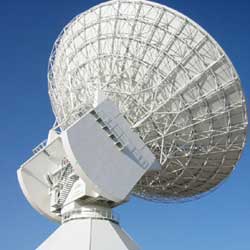
The European Space Agency’s Cebreros radio telescope in Spain. Image credit: ESA. Click to enlarge.
On 9 June, a powerful new 35-metre antenna, presently undergoing acceptance testing at Cebreros, Spain, successfully picked up signals and tracked Rosetta and SMART-1. It is ESA’s second deep-space ground station in its class and adds Ka-band reception capability and high pointing precision to the ESTRACK network.
Construction of the new ground station, located in the Spanish province of Avila, has proceeded in record time. Procurement activities started in February 2003, and in spring 2004, on-site work was initiated.
After successful assembly of the antenna structure in November 2004 and the acceptance testing of radio-frequency components, the system is now entering final on-site testing. All portions of the antenna’s infrastructure, including power systems, buildings and communications, are already complete and are ready to hand over for operations.
Tuned in to signals from distant space
Successful reception of signals from the two spacecraft demonstrates that the antenna is working well. Rosetta, Europe’s comet-chaser, is presently 46 million km from Earth while SMART-1 is orbiting the Moon.
Cebreros will be capable of receiving signals in the X and Ka bands. The X band (7-8 GHz) is used for routine telecommanding and to transmit high-volume data to Earth; the Ka band (32 GHz) offers enhanced data reception rates and will be used for future missions.
Additional measurements using radio-emitting stars gave good first results with respect to pointing accuracy and antenna performance, indicating that the station’s specifications will be met.
Full operational readiness of the antenna is anticipated for 30 September 2005, and Cebreros is subsequently scheduled to swing into operation to support the Venus Express mission, scheduled for launch on 26 October 2005.
With Cebreros, Spain, and New Norcia, Australia, ESA spacecraft operations will benefit from two 35-metre deep-space antennas. Future plans foresee the possible construction of a third 35-metre station at an American longitude to become ready by the end of 2009.
ESTRACK family grows
Cebreros is the latest station to join ESTRACK, ESA’s worldwide network of ground stations operated from the agency’s Space Operations Centre (ESOC) in Darmstadt, Germany. Ground stations are used for sending commands to spacecraft and receiving data from onboard instruments.
With Cebreros, there are 8 stations in ESTRACK, located in Europe, Africa, South America and Australia. Additional stations in Kenya, Chile and Norway are available when needed. The system is highly automated and most stations run with little or no manned intervention for routine operations, providing a significant cost benefit.
Original Source: ESA News Release
Planets Under Construction
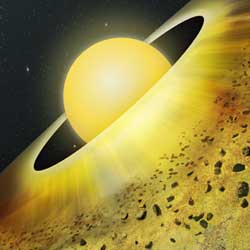
Artist illustratino of a planetary zone filled with pebbles. Image credit: CfA. Click to enlarge.
Interstellar travelers might want to detour around the star system TW Hydrae to avoid a messy planetary construction site. Astronomer David Wilner of the Harvard-Smithsonian Center for Astrophysics (CfA) and his colleagues have discovered that the gaseous protoplanetary disk surrounding TW Hydrae holds vast swaths of pebbles extending outward for at least 1 billion miles. These rocky chunks should continue to grow in size as they collide and stick together until they eventually form planets.
“We’re seeing planet building happening right before our eyes,” said Wilner. “The foundation has been laid and now the building materials are coming together to make a new solar system.”
Wilner used the National Science Foundation’s Very Large Array to measure radio emissions from TW Hydrae. He detected radiation from a cold, extended dust disk suffused with centimeter-sized pebbles. Such pebbles are a prerequisite for planet formation, created as dust collects together into larger and larger clumps. Over millions of years, those clumps grow into planets.
“We’re seeing an important step on the path from interstellar dust particles to planets,” said Mark Claussen (NRAO), a co-author on the paper announcing the discovery. “No one has seen this before.”
A dusty disk like that in TW Hydrae tends to emit radio waves with wavelengths similar to the size of the particles in the disk. Other effects can mask this, however. In TW Hydrae, the astronomers explained, both the relatively close distance of the system and the stage of the young star’s evolution are just right to allow the relationship of particle size and wavelength to prevail. The scientists observed the young star’s disk with the VLA at several centimeter-range wavelengths. “The strong emission at wavelengths of a few centimeters is convincing evidence that particles of about the same size are present,” Claussen said.
Not only does TW Hydrae show evidence of ongoing planet formation, it also shows signs that at least one giant planet may have formed already. Wilner’s colleague, Nuria Calvet (CfA), has created a computer simulation of the disk around TW Hydrae using previously published infrared observations. She showed that a gap extends from the star out to a distance of about 400 million miles – similar to the distance to the asteroid belt in our solar system. The gap likely formed when a giant planet sucked up all the nearby material, leaving a hole in the middle of the disk.
Located about 180 light-years away in the constellation Hydra the Water Snake, TW Hydrae consists of a 10 million-year-old star about four-fifths as massive as the Sun. The protoplanetary disk surrounding TW Hydrae contains about one-tenth as much material as the Sun – more than enough to form one or more Jupiter-sized worlds.
“TW Hydrae is unique,” said Wilner. “It’s nearby, and it’s just the right age to be forming planets. We’ll be studying it for decades to come.”
This research was published in the June 20, 2005, issue of The Astrophysical Journal Letters.
Headquartered in Cambridge, Mass., the Harvard-Smithsonian Center for Astrophysics (CfA) is a joint collaboration between the Smithsonian Astrophysical Observatory and the Harvard College Observatory. CfA scientists, organized into six research divisions, study the origin, evolution and ultimate fate of the universe.
Original Source: Harvard CfA News Release
Pan’s Influence on the Rings
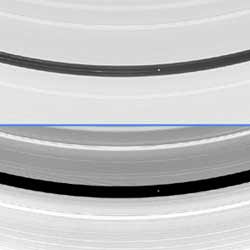
Saturn’s moon Pan makes ripples in the rings as it orbits the planet. Image credit: NASA/JPL/SSI. Click to enlarge.
Saturn’s moon Pan is seen here orbiting within the Encke Gap in Saturn’s A ring in two differently processed versions of the same Cassini image. The little moon is responsible for clearing and maintaining this gap, named for Johann Franz Encke, who discovered it in 1837. Pan is 20 kilometers (12 miles) across.
The top image reveals two of the faint, dusty ringlets that occupy the gap along with Pan. One of the ringlets occupies nearly the same orbit as Pan, while the other is closer to the gap’s inner edge. Not only do the ringlets vary in brightness, but they also appear to move in and out along their length, resulting in notable “kinks,” which are similar in appearance to those observed in the F ring (see PIA06585). One possible explanation for the complex structure of the ringlets is that Pan may not be the only moonlet in this gap.
Pan is responsible for creating stripes, called ‘wakes,’ in the ring material on either side of it. Since ring particles closer to Saturn than Pan move faster in their orbits, these particles pass the moon and receive a gravitational “kick” from Pan as they do. This kick causes waves to develop in the gap where the particles have recently interacted with Pan (see PIA06099), and also throughout the ring, extending hundreds of kilometers into the rings. These waves intersect downstream to create the wakes, places where ring material has bunched up in an orderly manner thanks to Pan’s gravitational kick.
In the bottom image, the bright stripes or wakes moving diagonally away from the gap’s edges can be easily seen. The particles near the inner gap edge have most recently interacted with Pan and have just passed the moon. Because of this, the disturbances caused by Pan on the inner gap edge are ahead of the moon. The reverse is true at the outer edge: the particles have just been overtaken by Pan, leaving the wakes behind it.
This image was taken in visible light with the Cassini spacecraft narrow-angle camera on May 18, 2005, at a distance of approximately 1.6 million kilometers (1 million miles) from Pan and at a Sun-Pan-spacecraft, or phase, angle of 44 degrees. The image scale is 9 kilometers (6 miles) per pixel.
The Cassini-Huygens mission is a cooperative project of NASA, the European Space Agency and the Italian Space Agency. The Jet Propulsion Laboratory, a division of the California Institute of Technology in Pasadena, manages the mission for NASA’s Science Mission Directorate, Washington, D.C. The Cassini orbiter and its two onboard cameras were designed, developed and assembled at JPL. The imaging team is based at the Space Science Institute, Boulder, Colo.
For more information about the Cassini-Huygens mission visit http://saturn.jpl.nasa.gov. For additional images visit the Cassini imaging team homepage http://ciclops.org.
Original Source: NASA/JPL/SSI News Release
